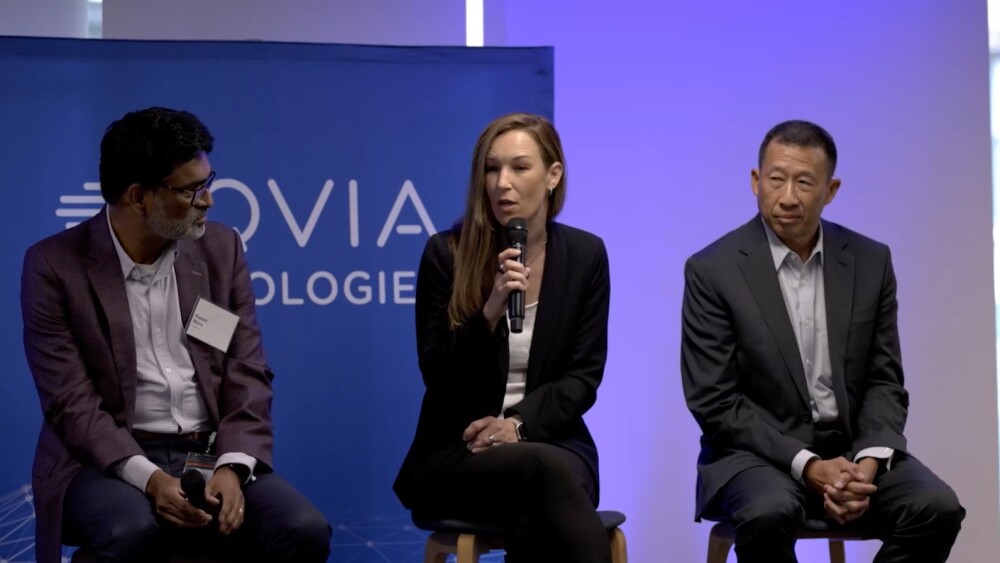iCAD, Inc. (NASDAQ: ICAD), a global medical technology leader providing innovative cancer detection and therapy solutions, today announced the first metastatic brain tumor was treated in the U.S. with intraoperative radiation therapy (IORT) using the Xoft® Axxent® Electronic Brachytherapy (eBx®) System®.
NASHUA, N.H., Feb. 11, 2020 (GLOBE NEWSWIRE) -- iCAD, Inc. (NASDAQ: ICAD), a global medical technology leader providing innovative cancer detection and therapy solutions, today announced the first metastatic brain tumor was treated in the U.S. with intraoperative radiation therapy (IORT) using the Xoft® Axxent® Electronic Brachytherapy (eBx®) System®. This procedure is the start of a clinical trial on IORT for patients with large brain metastases treated with neurological resection with the Xoft System, led by Shiao Yuo Woo, MD, FACR, radiation oncologist, James Graham Brown Cancer Center at the University of Louisville.1
“We are very excited to open this clinical trial, and hope our results show intraoperative balloon-based brachytherapy is both well-tolerated and effective for sterilizing subclinical disease in the tumor bed after resection of large brain metastases,” said Mehran Yusuf, MD, radiation oncologist, James Graham Brown Cancer Center at the University of Louisville. “This project would not have been possible without the support and coordination of an excellent team of neurosurgeons, radiation oncologists, medical physicists, clinical research staff within the University of Louisville Health, and continued support from Xoft.”
The Xoft System is also currently being studied for the treatment of other types of brain tumors in leading institutions worldwide, including the European Medical Center, one of the largest private medical clinics in Russia and an international leader in comprehensive care and oncology. Positive preliminary clinical data on Xoft IORT for the treatment of recurrent glioblastoma (GBM) was presented at the European Association of Neurosurgical Societies (EANS) Congress in Dublin, Ireland in September 2019 by Alexey Gaytan, MD, PhD, neurosurgeon at the European Medical Center in Moscow, Russia. In a matched pair study, 30 patients were treated for recurrent GBM. The IORT group (A) was treated with a single fraction of radiation immediately following surgical resection, without chemotherapy or temozolomide following surgery. The comparison group (B) was treated with routine postoperative adjuvant chemotherapy +/- concomitant or sequential EBRT. Median overall survival (OS) in group A was 24 months; OS for group B was 21 months. As of September 2019, nine patients were still alive from group A, whereas none of the patients in group B survived.
A retrospective analysis published in World Neurosurgery by Alexey Krivoshapkin, MD, PhD, et al. examined the repeat resection and the various methods of IORT for the treatment of malignant brain gliomas (MBGs), including high-energy linear accelerators and modern, integrated brachytherapy solutions using solid and balloon applicators.2 The findings from this review showed IORT with balloon applicators to be particularly promising.
Worldwide, almost 297,000 cases of brain and nervous system tumors are diagnosed per year.3 GBM is the most common and aggressive type of malignant primary brain tumor, with a median survival of 10-12 months.4,5 Treatment for brain tumors typically involves surgical removal, followed by radiation therapy or chemotherapy.
The Xoft System is FDA-cleared, CE marked and licensed in a growing number of countries for the treatment of cancer anywhere in the body. It uses a miniaturized x-ray source to deliver a precise, concentrated dose of radiation directly to the tumor site, while minimizing risk of damage to healthy tissue in nearby areas of the body. IORT with the Xoft System allows radiation oncologists and surgeons to work together to deliver a full course of radiation treatment in one day, at the time of surgery, while the patient is under anesthesia. Once the tumor has been surgically removed, the Xoft System’s miniature x-ray source is inserted inside a flexible balloon-shaped applicator, which is then placed inside the tumor cavity, filled with saline, and used to deliver a single dose of radiation directly to the tumor bed. For the treatment of certain types of brain tumors, IORT with the Xoft System may allow appropriately selected patients to potentially replace weeks of post-operative external beam radiation therapy (EBRT) with a single fraction of radiation.
“Brain IORT with the Xoft System is a groundbreaking procedure that has potential to extend lives and address a significant unmet need in the treatment of several types of cancers including metastatic brain tumors and GBM,” according to Michael Klein, Chairman and CEO of iCAD. “This promising treatment option may improve outcomes and quality of life for patients, with a shorter treatment duration and minimal side effects compared to EBRT, which involves weeks of daily radiation treatments. This is a significant milestone for iCAD and represents just one of the exciting new and emerging applications we are currently exploring with the Xoft System, and we look forward to partnering with additional prominent investigators as our research continues.”
References:
- University of Louisville. Study of Intraoperative Radiotherapy for Patients With Large Brain Metastases Treated With Neurosurgical Resection. Accessed via https://clinicaltrials.gov/ct2/show/NCT04040400. ClinicalTrials.gov Identifier: NCT04040400.
- Krivoshapkin A, et al. Repeat Resection and Intraoperative Radiotherapy for Malignant Gliomas of the Brain: A History and Review of Current Techniques. World Neurosurgery (2019) 132: 356-362. Accessed via https://doi.org/10.1016/j.wneu.2019.09.037.
- WHO, IARC, Globocan Cancer Incidence and Mortality Worldwide in 2018. Accessed via https://gco.iarc.fr/today/data/factsheets/populations/900-world-fact-sheets.pdf.
- Tamimi AF, Juweid M. Epidemiology and Outcome of Glioblastoma. In: De Vleeschouwer S, editor. Glioblastoma [Internet]. Brisbane (AU): Codon Publications; 2017 Sep 27. Chapter 8. Accessed via https://www.ncbi.nlm.nih.gov/books/NBK470003.
- Pan E, Prados MD. Glioblastoma Multiforme and Anaplastic Astrocytoma. In: Kufe DW, Pollock RE, Weichselbaum RR, et al., editors. Holland-Frei Cancer Medicine. 6th edition. Hamilton (ON): BC Decker; 2003. Accessed via https://www.ncbi.nlm.nih.gov/books/NBK12526/.
About iCAD, Inc.
Headquartered in Nashua, NH, iCAD is a global medical technology leader providing innovative cancer detection and therapy solutions. For more information, visit www.icadmed.com.
Forward-Looking Statements
Certain statements contained in this News Release constitute “forward-looking statements” within the meaning of the Private Securities Litigation Reform Act of 1995, including statements about the future prospects for the Company’s technology platforms and products. Such forward-looking statements involve a number of known and unknown risks, uncertainties and other factors which may cause the actual results, performance or achievements of the Company to be materially different from any future results, performance or achievements expressed or implied by such forward-looking statements. Such factors include, but are not limited, to the Company’s ability to defend itself in litigation matters, to achieve business and strategic objectives, the risks of uncertainty of patent protection, the impact of supply and manufacturing constraints or difficulties, uncertainty of future sales levels, protection of patents and other proprietary rights, the impact of supply and manufacturing constraints or difficulties, product market acceptance, possible technological obsolescence of products, increased competition, litigation and/or government regulation, changes in Medicare or other reimbursement policies, risks relating to our existing and future debt obligations, competitive factors, the effects of a decline in the economy or markets served by the Company; and other risks detailed in the Company’s filings with the Securities and Exchange Commission. The words “believe,” “demonstrate,” “intend,” “expect,” “estimate,” “will,” “continue,” “anticipate,” “likely,” “seek,” and similar expressions identify forward-looking statements. Readers are cautioned not to place undue reliance on those forward-looking statements, which speak only as of the date the statement was made. The Company is under no obligation to provide any updates to any information contained in this release. For additional disclosure regarding these and other risks faced by iCAD, please see the disclosure contained in our public filings with the Securities and Exchange Commission, available on the Investors section of our website at http://www.icadmed.com and on the SEC’s website at http://www.sec.gov.
Contacts:
Media inquiries:
Jessica Burns, iCAD
+1-201-423-4492
jburns@icadmed.com
Investor inquiries:
Jonathan Wexler, Scope Investor Relations, LLC
+1-203-247-8767
Jonathan@ScopeIR.com





